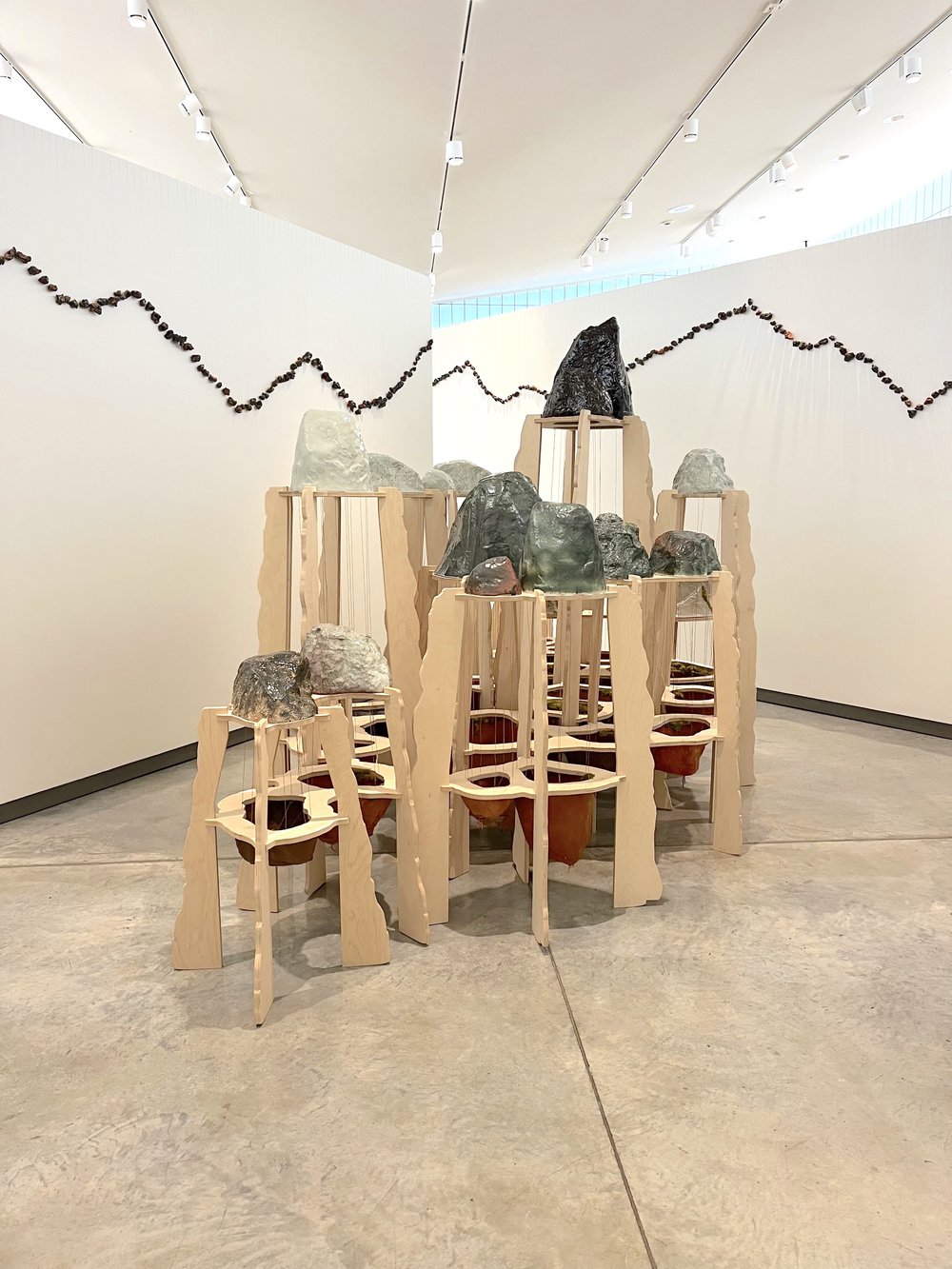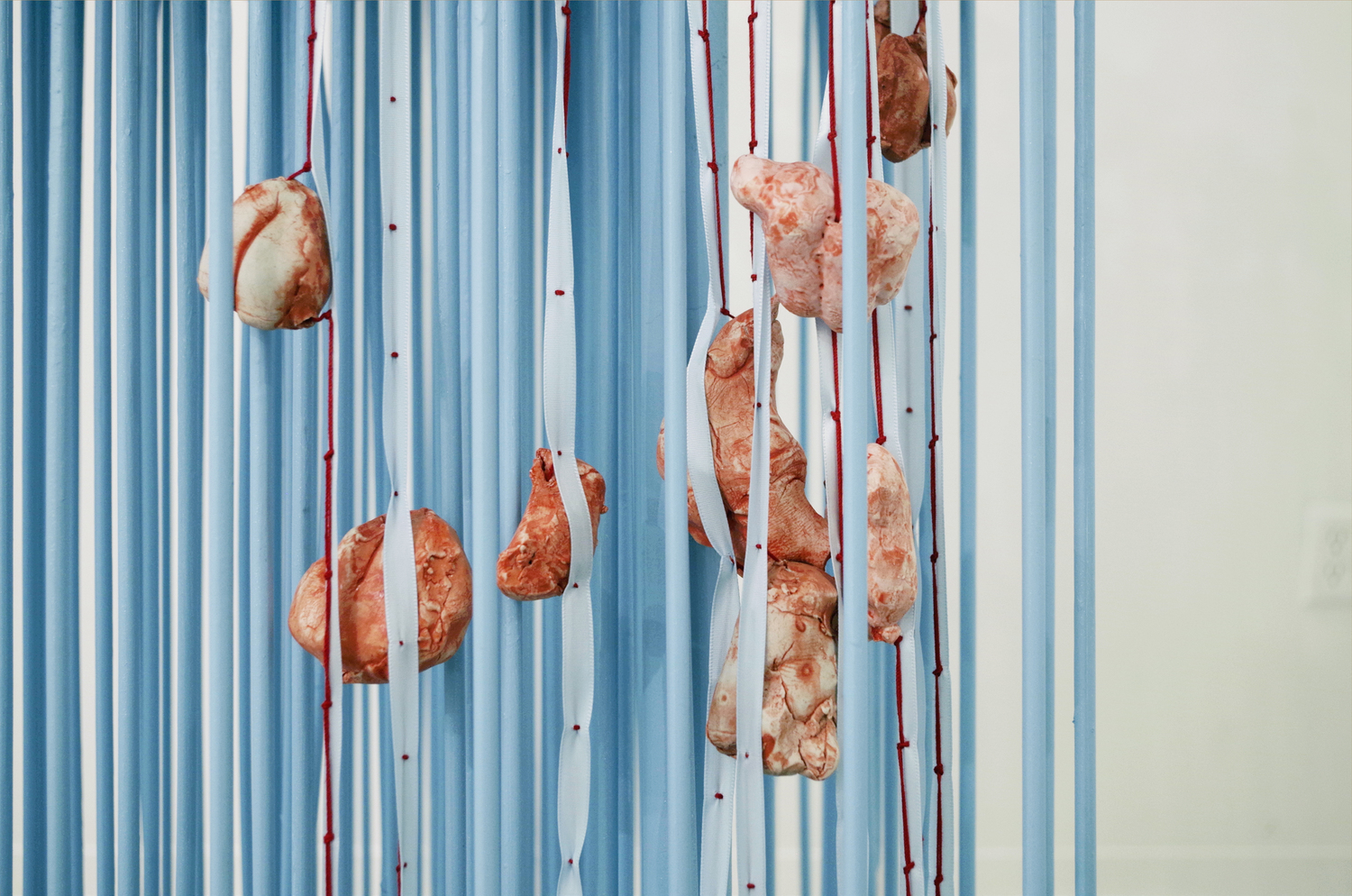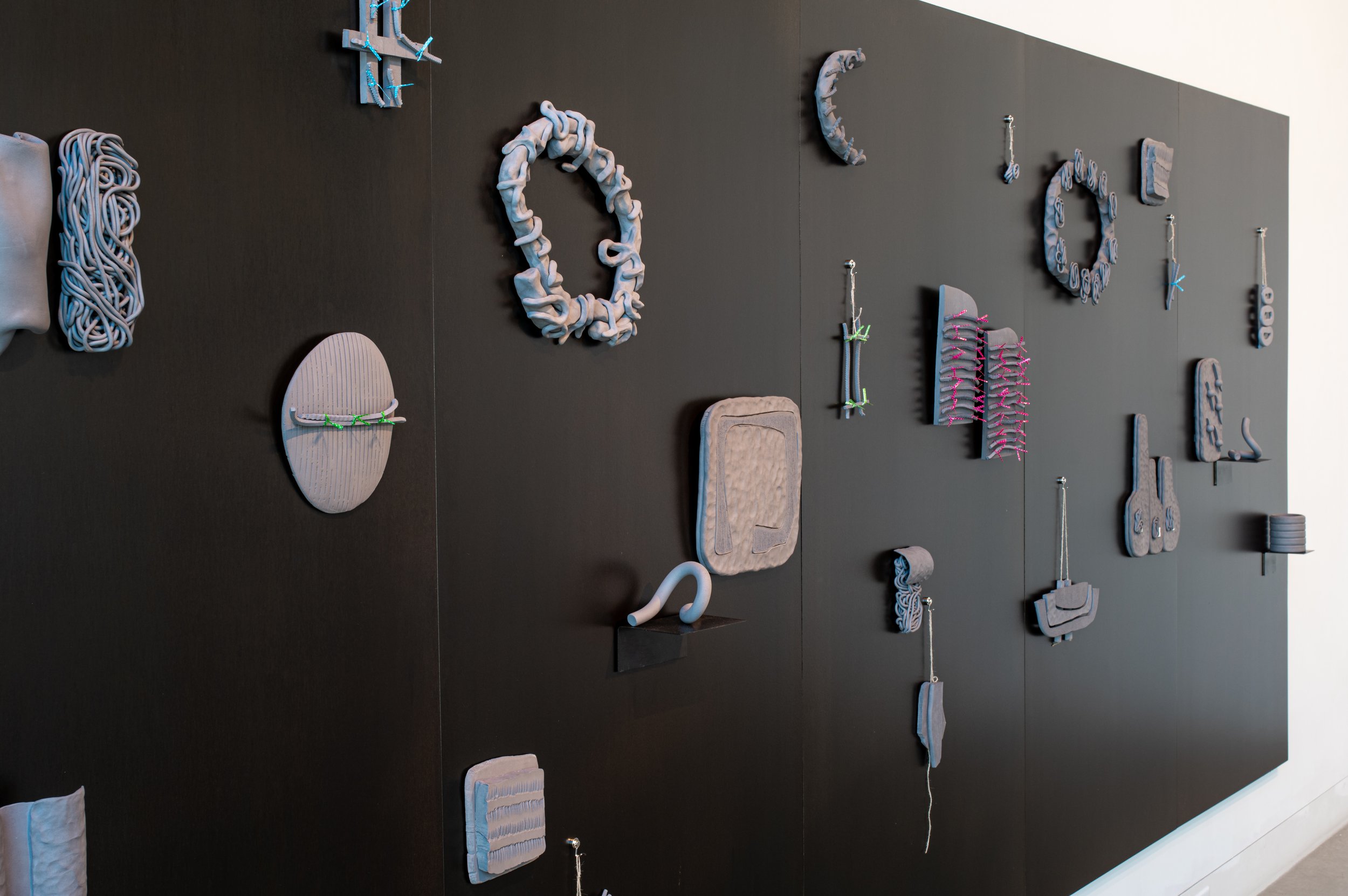Ceramics
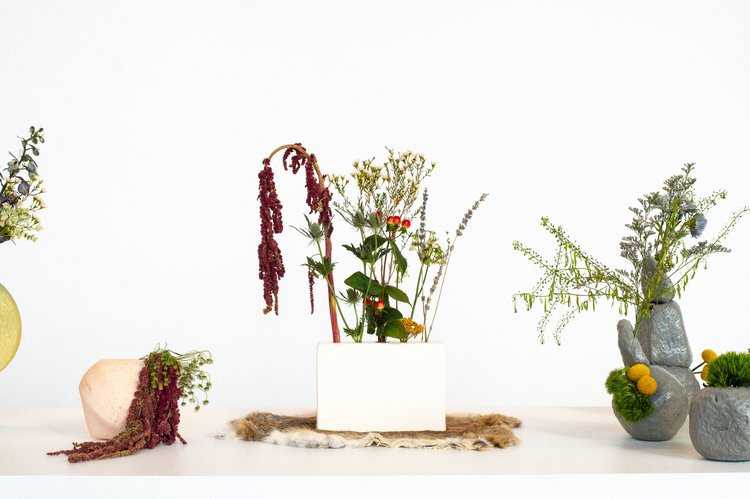
Program Overview
The undergraduate ceramics curriculum provides a firm base from which students develop a personal and singular approach to art-making, emphasizing early technical development and building toward self-determined investigations relating to the material. Students build skills in all major forming methods–including wheel-throwing, hand-building and slip-casting–and are exposed to various firing techniques and clay and glaze formulation.

DEGREE PROGRAMS
Ceramics students are encouraged to consider clay in combination with performance, video, sound, interactivity, installation, digital fabrication, and more. Experimentation and research are stressed as students are taught to exploit materials and processes for their conceptual ramifications, and to identify critical dialogues in which to contextualize their work. This developmental process is begun and reinforced through interaction with peers, faculty, artists in the regional community, visiting artists, and other scheduled art events.
Bachelor of Fine Arts, Ceramics Concentrations
The B.F.A Studio Art degree program is designed to offer students a more specialized program of study. Students will experience a greater emphasis on studio art courses in the B.F.A. program, graduating with a more intensive studio background. This degree requires twenty-one credit hours of ceramics coursework in combination with all other B.F.A. requirements. In addition, B.F.A. students are required to participate in a three credit-hour professional development capstone course in their final year. Students who wish to pursue a B.F.A. degree must first be admitted to the B.F.A. program.
The B.F.A. Studio Art in Ceramics is a professional degree with the purpose of training and preparing students to become ceramic artists. During the fours years of study each student is expected to learn a wide range of ceramics skills and techniques used in the field while focusing on their own ideas and way of making that are contextualized in contemporary art and ceramics. The B.F.A. program allows students to work closely with instructors, resulting in greater attention and advancement in the student’s work. Senior B.F.A. students are offered dedicated studio space to work independently on their studio projects.
B.F.A. students are required to participate in an individual critique of their work every year. Each student displays recent work for critique by faculty, visiting artists, and other students. In addition, B.F.A. students also participate in a capstone exhibition upon graduation from the program.
Bachelor of Arts
The Bachelor of Arts, B.A., with a concentration in Studio Art is a liberal arts oriented degree consisting of 120 hours, with a major emphasis in one studio area, and a minor emphasis in a second studio area. The course study is designed to offer students a broad cultural education and is ideal for students wishing to do a double major or to minor in another area.
The degree requires twelve credit hours of selected media area coursework for a major emphasis and six hours of selected media area coursework for a minor emphasis, as well as three-credit-hour professional development capstone course.
In addition, a faculty supervised summary critique is required of each student in their studio area their senior year. Studio areas include: ceramics, drawing, painting, photography, printmaking and sculpture.
Learn more |

COURSES
This introductory course investigates the techniques, materials, and themes common to hand-built ceramics. Students will also be introduced to ceramic studio processes, including clay and glaze mixing, low temperature gas and electric firing, and studio safety procedures.
This introductory course investigates the techniques, materials, and themes common in wheel-thrown ceramics. Students will also be introduced to ceramic studio processes, including clay and glaze mixing, high temperature gas and electric firing, and studio safety procedures.
This concept-driven intermediate-level course focuses on expanding the students' skills and knowledge of wheel-thrown and hand-built forms. Additional emphasis will be placed on clay and glaze testing, and understanding the processes of firing in electric, gas, salt/soda, and wood-firing kilns.
This concept-driven intermediate-level course focuses on the techniques and approaches common to ceramic slip-casting. Plaster mold-making, model development and preparation, slip mixing, and slip-casting are emphasized. Students will utilize low and high temperature gas and electric firings.
Focuses on discovering and developing a personal approach to the creation of ceramic objects. Students will explore and test clay bodies, surface treatments, and firing methods while simultaneously exploring ideas, formats, contexts, and interpretations to their work. Any or all ceramic processes may be used.
Focuses on discovering and developing a personal approach to the creation of ceramic objects. Students will explore and test clay bodies, surface treatments, and firing methods while simultaneously exploring ideas, formats, contexts, and interpretations to their work. Any or all ceramic processes may be used.
Advanced study of ceramic materials and processes. Clay composition, clay body formulation and analysis, glaze composition and formulation, firing methods (low, mid, and high-temperature gas, electric and atmospheric firings), and kiln design will be covered in depth.
This course focuses on the generation and development of ideas and objects to form a cohesive body of work. Students will lead their own explorations, technically and conceptually, while working toward a professional-level standard of output. Any or all ceramic processes may be used.
Individual projects in ceramic techniques.
Special projects on an arranged basis for advanced students in any area of art in which the catalog sequence of courses has been completed.

POST-BACCALAUREATE RESIDENT ARTIST PROGRAM
At the University of Arkansas, we understand the post-baccalaureate as someone moving through a transitional stage toward a pre-determined goal. For many this goal is admission into a top-tier graduate program, for others it may be the development of a body of work that launches a professional studio practice. The goals are varied, but whatever they may be, post-bac residents at the University of Arkansas are given the time and resources to ensure their goals can be met.
Our program can accommodate residents for 1 or 2 years. Post-bacs work side by side with graduate students in our ceramics seminar course. The topics of this course vary from semester to semester, but it always give residents ample opportunity for critical feedback, theoretical development, and professional practice. Many also take advantage of opportunities to attend advanced undergraduate and technical ceramics courses, which are available to our post-bacs at no additional cost. Furthermore, there are opportunities each semester for one-on-one guidance from the ceramics faculty. A requirement of the program is to present a new body of work at the end of each semester, for review by your peers and the ceramics faculty as a whole. At the conclusion of the first academic year, residents who wish to continue for a second year must demonstrate through their portfolio that sufficient progress has been made in the preceding semesters. Total cost for the program is 950 dollars per semester. Images from current post-bacs can be seen by following our Instagram.
Our post-bacs occupy a generous group studio space adjacent to the graduate and B.F.A. studios. The space is 650 square feet and is typically divided among four residents. Each post-bac has a dedicated table, shelving, ware cart, sculpture stand, and potter’s wheel (if needed). Residents collectively decide on the division and origination of their studio according to the needs of the group. There is easy access to kilns, mixers, raw materials, and all other studio equipment. Our studio is among the finest you will find at any university in North America.
We expect our post-bac residents to be studio leaders, demonstrating a high level of commitment to their own work and also to the betterment of the studio as a whole. Active membership in our ceramics club (the Association of Ceramic Enthusiasts) is an important part of the post-bac experience, helping to place each post-bac at the center of the ceramics community. ACE organizes multiple events each year to help raise funds for visiting artists, offset costs for students who wish to attend the annual NCECA conference, and to help contribute to studio improvements. We also expect that each resident contribute 2-3 hours each week to the operation of the studio. This could mean managing kiln meetings, overseeing our critique space, loading kilns, or other tasks that help the studio run effectively.
Application materials must be submitted by April 15th and applicants will be notified by email no later than May 1st. We welcome interested students to visit the department firsthand or to speak with faculty about their interest in the program before applying. For more information please email Mathew McConnell at msmcconn@uark.edu.
The following materials will be required for applying:
-
A short letter stating your interest in the program and the immediate goals you wish to pursue
-
Ten images of your work
-
One-page artist statement
-
Resume
-
Two names of professional references
Applications will be accepted via Slideroom
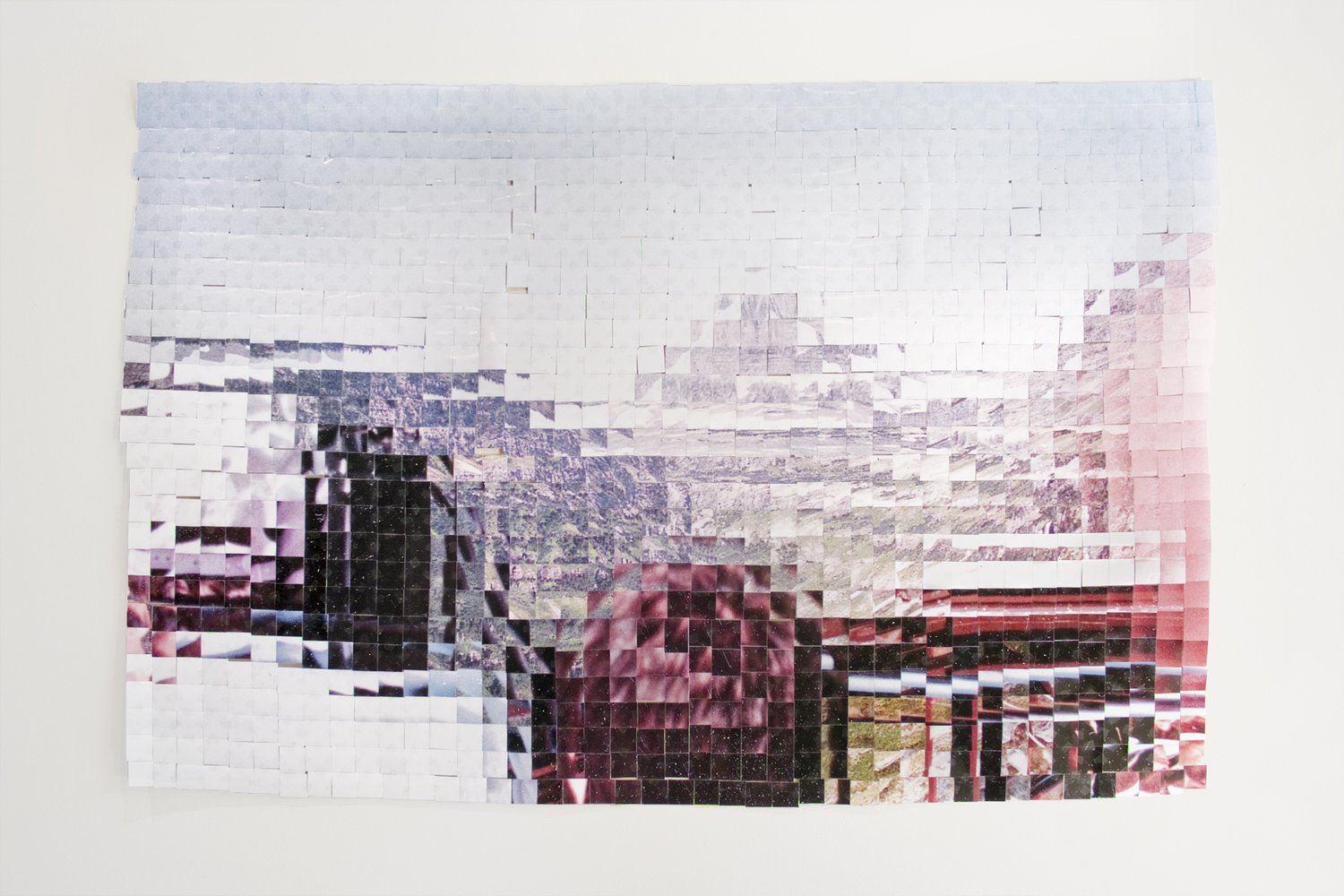
CLAY BREAK
Clay Break is a ceramics residency tailored to artists whose primary training and focus lie outside of ceramics.
UARK Ceramics is a thriving community of ceramic artists, educators, and students with an interest in fostering a rich dialogue about clay’s role in contemporary art. Clay Break is an opportunity for us to open our doors and share our facilities and knowledge with artists who are clay-curious. The program was conceived with an awareness that for those who want to familiarize or reacquaint themselves with the material, locating a supportive environment that also provides a significant time period for uninterrupted development can be a challenge. We want to help. Our commitment is to provide the time, space, facilities, and a supportive community to assist our residents in the creation of a body of new works in clay—we wish to give our residents a break from the established routines of their practice, and help them discover something new for themselves in clay.
During Fall 2025, two artists will each participate in a one-month residency running during the Fall 2025 semester.
A furnished studio is provided, along with stocked ceramic materials, kiln firings, and a modest stipend. UARK Ceramics faculty and graduate students will be available to help familiarize residents with basic studio processes and help guide them through technical problems as they arise. The duration of the residency, and timing varies according to the needs of the residents and availability of space and faculty support. Most residents stay for 8-10 weeks.
We expect our residents to be generous and conscientious community members. Selected artists should demonstrate a high level of engagement with faculty/students and help to promote a healthy and productive studio community, as well as to their own work. To this end, we ask that the residents be on-site in the ceramics studio for at least 40 hours per week, perform one public lecture over the course of their stay, conduct 1-2 studio visits per week, and engage in communal studio activities when possible (potlucks, exhibition openings, etc.) We also request that one piece made during the residency be donated to the UARK Ceramics Teaching Collection.
Ample studio space will be available for residents. This space may be private or semi-private depending on the needs of the studio at that time. Located in the ceramics studio’s, the resident studios are at the heart of the Studio and Design Center and offer easy access to kilns, mixers, raw materials, and all other studio equipment. Access to studios is 24/7.
In fall 2025, each resident artist will receive a stipend of $3,500. Dry materials, studio glazes, and kiln firings are included in the residency—materials not available in our studios are the responsibility of the artist.
Currently, each artist is responsible for arranging their own travel and accommodations. We’re able to help you with recommendations and have relationships with several local rental companies.
Emerging, mid-career, and established artists who are looking for an opportunity to work in clay are welcomed to apply. Currently, residents are being through a juried selection process. Applications are due on April 15, 2025.
Clay Break Resident Profiles
 Stephen Burks and Malika Lieper, 2024
Stephen Burks and Malika Lieper, 2024
https://stephenburksmanmade.com/
Chicago native, Stephen Burks is an industrial designer, product development consultant, and educator whose innovative approach to design synthesizes craft, community, and industry. Independently and through association with various non-profits, he has collaborated with artisans and craftspeople in over ten countries on six continents. His socially engaged practice seeks to broaden the limits of design consciousness by challenging who benefits from and participates in contemporary design.
Stephen and his studio, Stephen Burks Man Made, have been commissioned by many of the world’s leading design-driven brands to develop collections that engage hand production as a strategy for innovation to express a more pluralistic vision of design.
He has had solo exhibitions and led curatorial projects at the Studio Museum in Harlem (Stephen Burks Man Made, 2011), the Museum of Art & Design (Stephen Burks, Are You a Hybrid, 2011), and the High Museum of Art (Stephen Burks: Shelter in Place, 2022).
Stephen is the only African-American to win the Smithsonian Cooper Hewitt National Design Award in Product Design, as well as the only industrial designer to be awarded the prestigious Loeb Fellowship at the Harvard Graduate School of Design.
 |
 |
 |
 |
Rashawn Griffin, 2022
George Perez, 2022
Wilder Alison, 2021
Magalie Guerin, 2021
Rachel James, 2021
Amanda Friedman, 2019
Dan Gunn, 2019
Adam Milner, 2019
Rebekah Chozick, 2020/21
Haynes Riley, 2019, Founder and Director, Good Weather LLC
FACULTY

Professor Jeannie Hulen is the Studio Art Program Director in the School of Art at the University of Arkansas. Her past leadership roleshave been Associate Dean in Fulbright College of Arts and Sciences from 2017-2023, and chair of the Department of Art. During her administrative leadership, she stewarded historic gifts for the School of Art, including $120 Million from the Walton Family Charitable Support Foundation and over $72 Million from the Windgate Charitable Foundation, for the establishment of an endowed world-class School of Art and new state of the art facilities. Her first appointment to the University of Arkansas as ceramics faculty was in 2002. She received a B.F.A. from the Kansas City Art Institute in 1995, and M.F.A. from Louisiana State University in 2000. She has exhibited internationally including many exhibitions in conjunction with the National Council for the Education of Ceramic Arts. In 2009 she was a Resident Visiting Artist at the Tainan National University of The Arts in Tainan, Taiwan. She currently has ongoing research in West Africa following her 2018-2019 US Fulbright Scholar post at the Kwame Nkrumah University of Science and Technology in Kumasi, Ghana.
|
|
|
|

Mathew McConnell (he/him) holds an M.F.A. from the University of Colorado, Boulder, and a B.F.A. from Valdosta State University in Georgia. He has held numerous solo exhibitions including at Mindy Solomon Gallery in Miami and the Jane Hartsook Gallery at Greenwich House Pottery in NYC. His works have been included in over 70 group exhibitions nationally and internationally. Mathew has lectured widely, and has been subject of feature-length articles in Ceramics Art and Perception, Ceramics Monthly, and New Ceramics. He has received an Emerging Artist Award from the National Council on Education in Ceramic Art, and has been an Artist in Residence at the Archie Bray Foundation, Greenwich House Pottery, and Anderson Ranch Arts Center.
|
|
|
|

Linda Nguyen Lopez (b. 1981, Visalia, California) is an American artist of Vietnamese and Mexican descent. Her abstract works explore the poetic potential of the everyday by imagining and articulating a vast emotional range embedded in the mundane objects that surround us. Lopez received a B.F.A. from California State University of Chico and an M.F.A. from the University of Colorado at Boulder. Her works have been exhibited in Italy, New Zealand, England and throughout United States including the Renwick Gallery at Smithsonian American Art Museum, Washington DC; Craft Contemporary Museum, Los Angeles; Crystal Bridges Museum of American Art, Bentonville; Long Beach Museum of Art, Long Beach; Springfield Art Museum, The Hole, New York; David B. Smith Gallery, Denver; Red Arrow Gallery, Nashville; and Museum of Art and Design, New York.
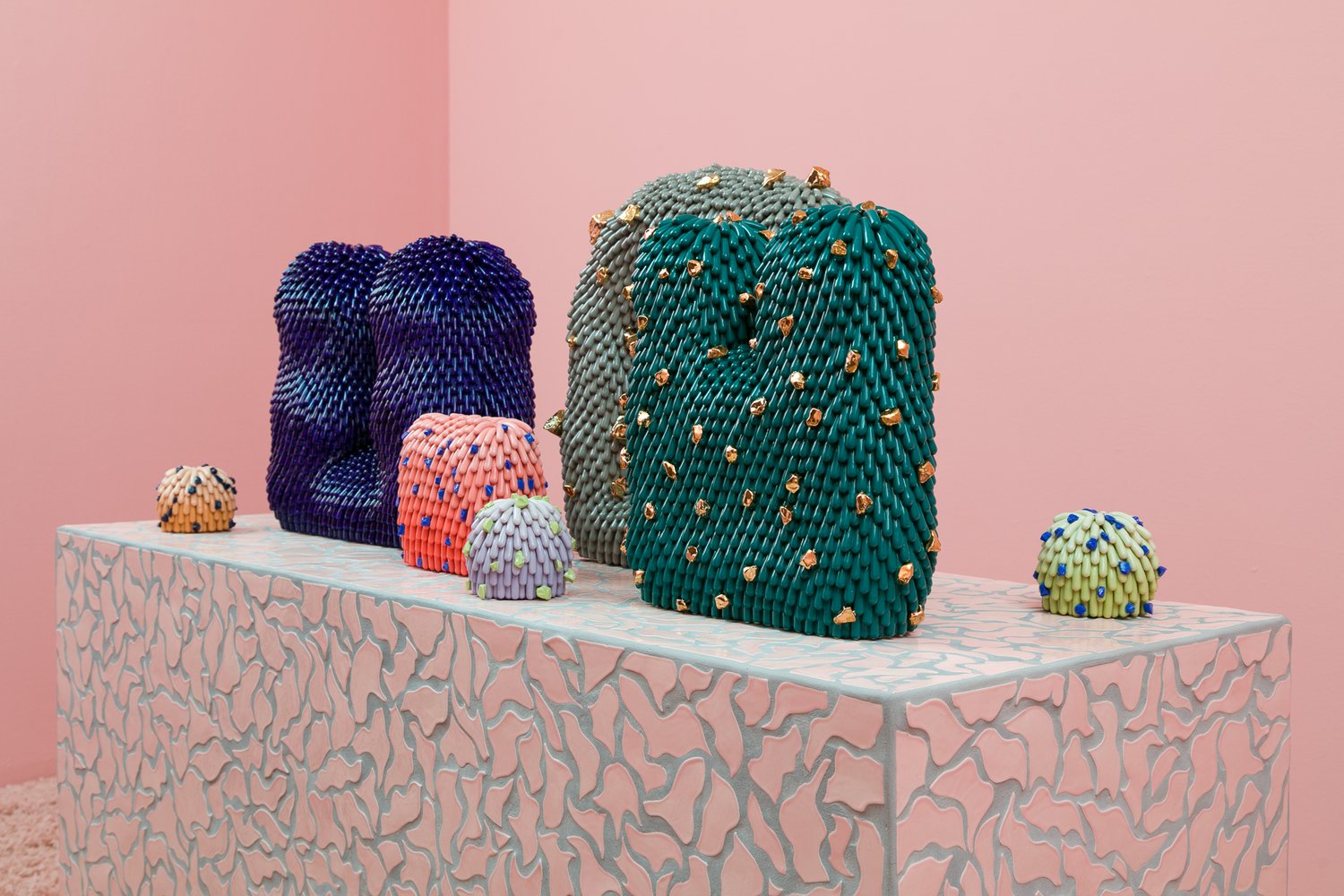 |
 |
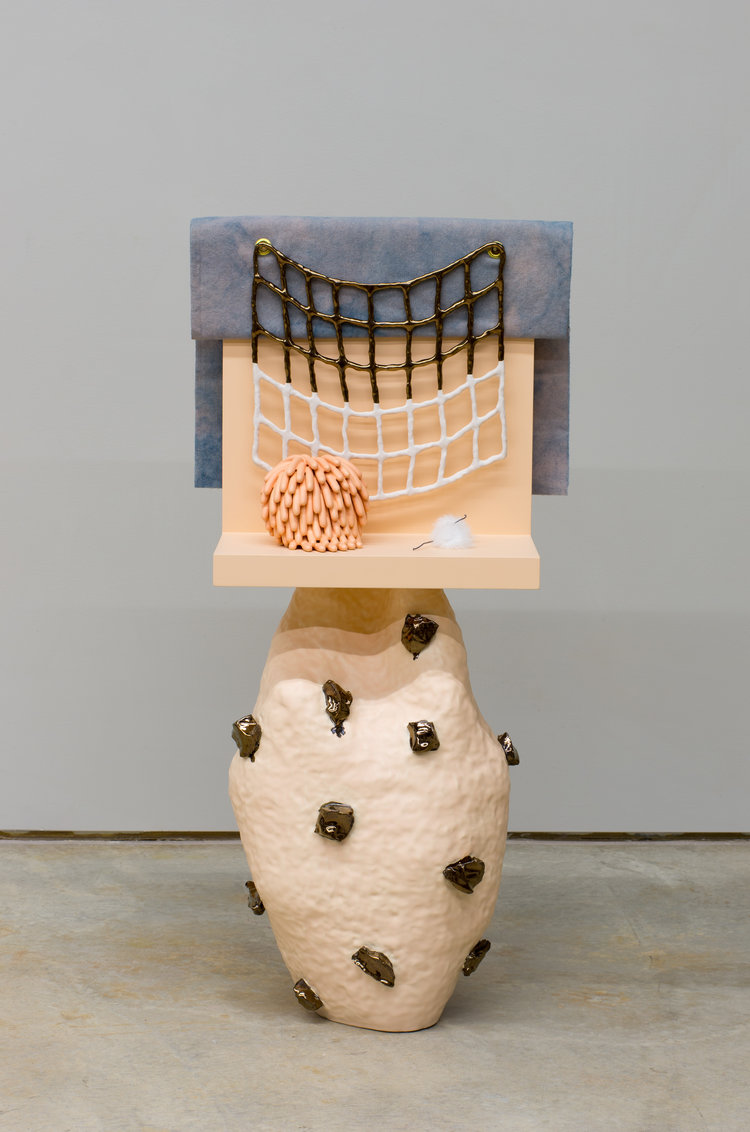 |

Adam holds a B.A. from Macalester College in 1995, and an M.F.A. from Louisiana State University in 1999. Adam has exhibited in nearly every corner of the United States, both in group and solo exhibitions. He has been featured in Ceramics Monthly and is the author of "To Serve the Divine: Making Pottery for African-Atlantic Religions" in Studio Potter magazine. Adam writes of his work, "I have been greatly inspired by West and Central-African traditions and the various African-inspired, syncretic religious-cultural practices of North, Central and South America, particularly those of Cuba and Haiti. Within the Afro-Cuban cosmological view specifically, the concept of “El Monte,” which in this context roughly translates as “The Wild,” has complex and deep significance." His work is currently available at The Clay Studio in Philadelphia, Red Lodge Clay Center in Montana, and Lillstreet Gallery in Chicago, among others.
https://adamposnak.com/home.html
 |
 |
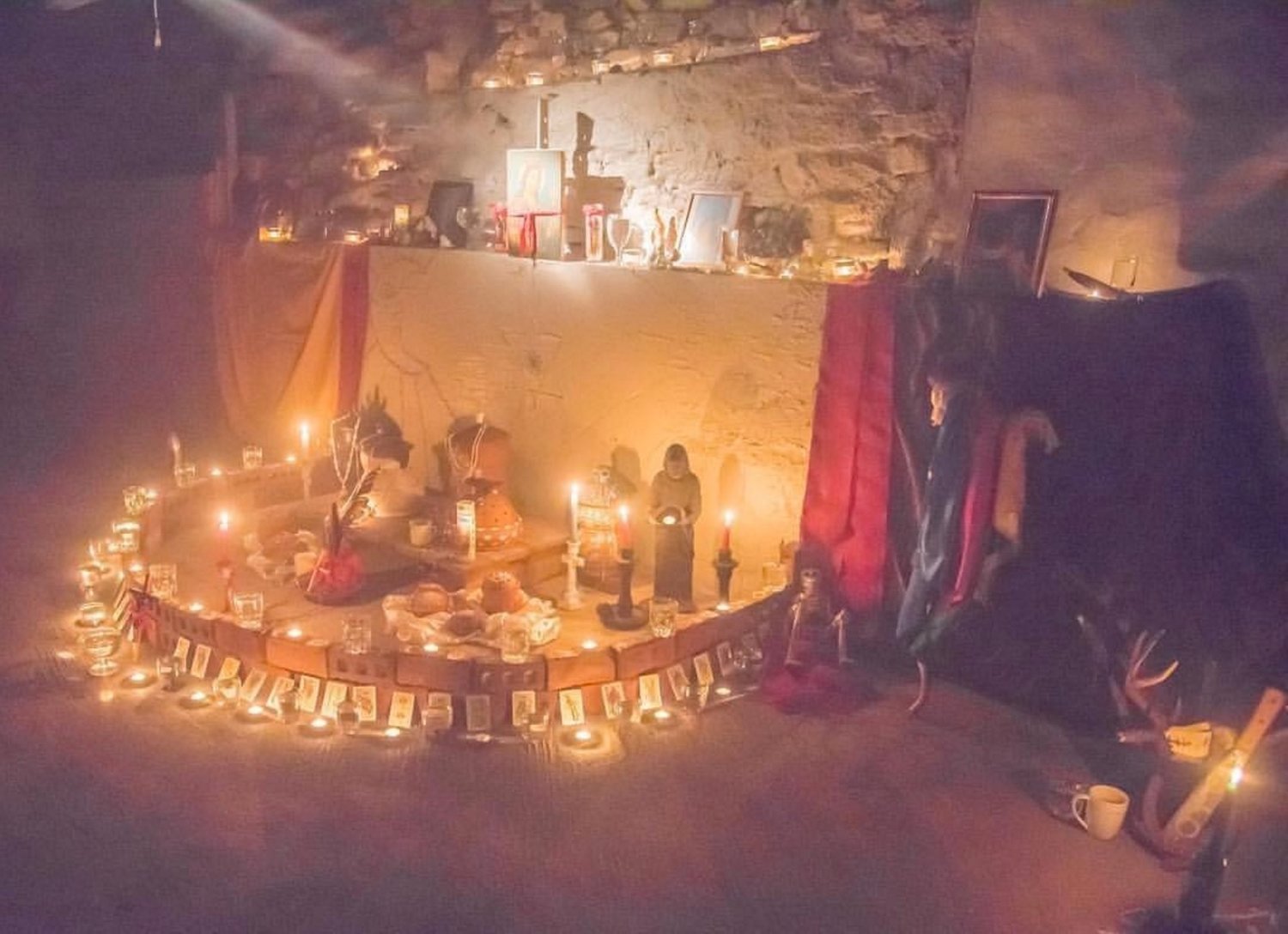 |

After years working alongside his dad at the family bronze foundry, Qwist Joseph received a B.F.A. from Colorado State University and an M.F.A. from the University of Nebraska-Lincoln. He has completed residencies at the Archie Bray Foundation, the Roswell Artist-in-Residence Program and the University of Denver. In 2019 Qwist received an emerging artist award from the National Council on Education in Ceramics Art. Qwist shows nationally and internationally, most recently in the Officine Saffi exhibition in Milan, Italy. He has taught at Chaffey College, the University of Redlands, the University of Denver and Pitzer College.
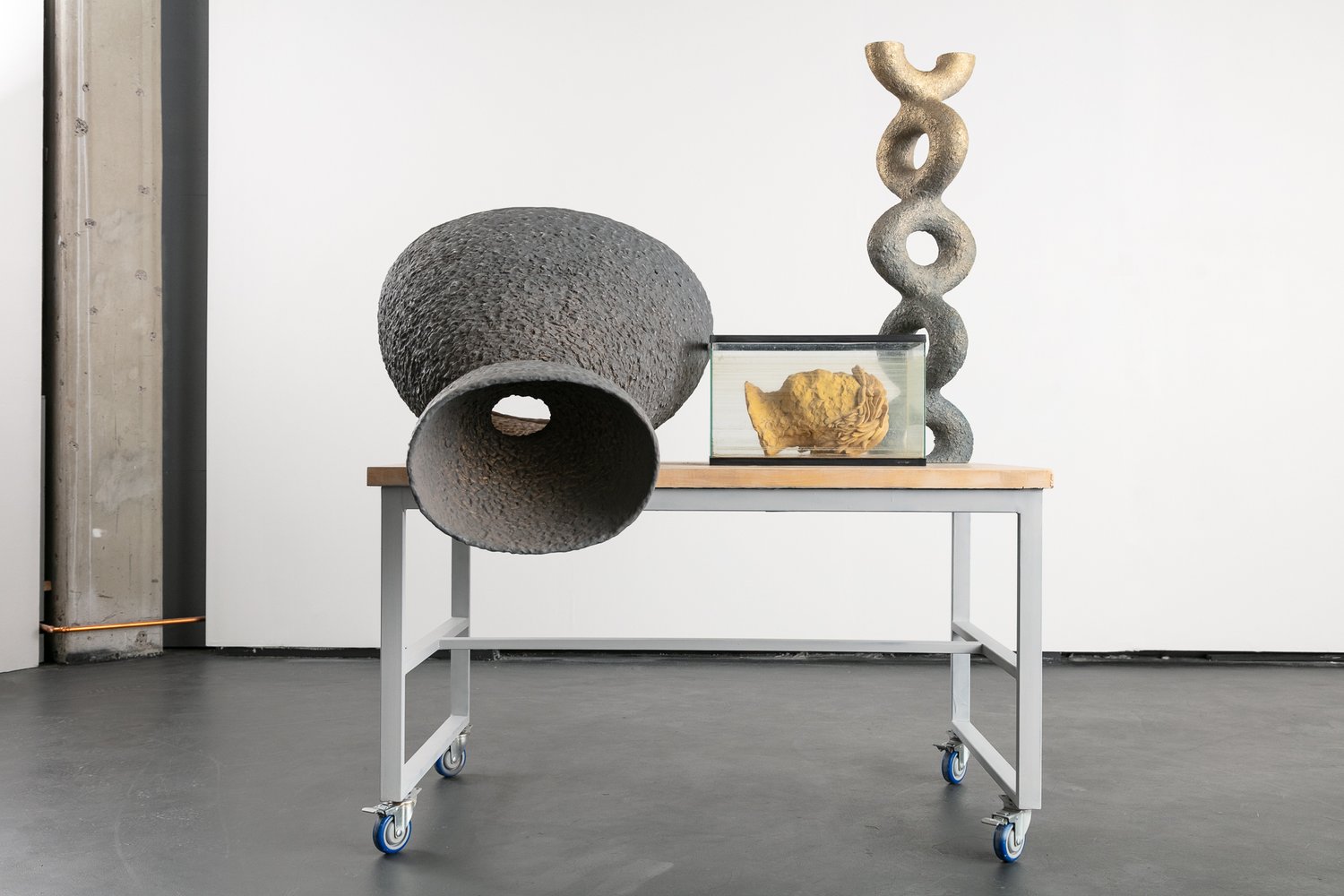 |
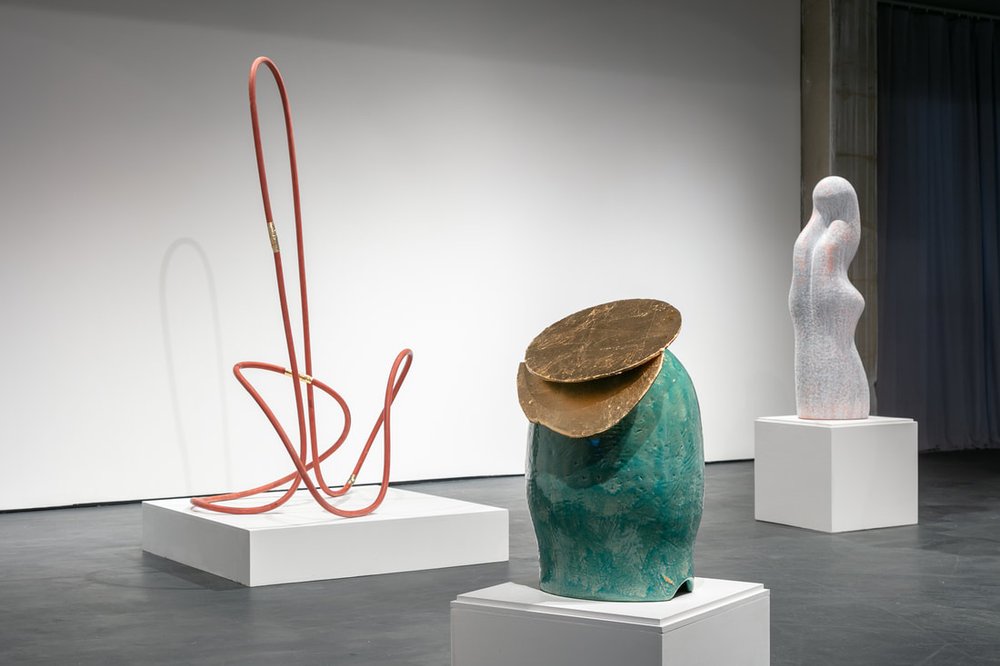 |
 |

FACILITIES + EQUIPMENT
UARK Ceramics boasts nearly 20,000 square feet of studio, classroom, installation, and lounge space on the ground floor of the Studio Art and Design Center (SDCR). Generously sized classrooms and support spaces are equipped for all standard ceramics processes. There are dedicated spaces for clay and glaze mixing, glaze application, plaster prototyping and mold making, material storage, photo documentation, and ample space for installing work. The main classroom itself converts into a 3000 square foot gallery space that can be employed for end of semester exhibitions and reviews.
The ceramics area has twelve individual studios that house our graduate students, faculty, and resident artists. Six of these studios, from 210 to 275 square feet, are earmarked for our M.F.A. students. These spaces are adjacent to the post-bac studio and resident artist studio, and are closely situated to the main classrooms. All spaces are amply sized with high ceilings, good light, and excellent ventilation throughout.
In the last ten years, more than $500,000 has been invested in equipment upgrades to complement our new facility and to further extend the technologies and processes available to our students. Below is a list of some of the major equipment we have available to our students:
INTERIOR Kiln Pad
- Blaauww automated 12 & 54 & 100 cu.ft. gas kilns
- Blaauww automated 18 cu.ft. electric kiln
- Bailey Studio Pro 12 & 18 cu.ft. gas kilns
- Bailey Thermal Logic 20 cu.ft. electric with two cars
- 12 computer-controlled Skutt electric kilns
-
Counterbalance stacker
INTERIOR Kiln Pad
- Geil 8, 12, and 24 cu.ft. gas kilns
- Master Kiln Builders 24 cu.ft. soda kiln
Technology Lab
- Potterbot Super 10 clay printer (2)
- Enduring Images color decal printer
- Shop Sabre CNC Router
- Shop Sabre CNC Plasma Cutter
- Epilog Fusion Laser Cutter (multiple)
- Various 3D Printers (Prusa, Ultimaker)
General Studio/Classrooms
- Brent and Bailey extruders
- Bailey slab rollers (2)
- 20+ electric wheels
- 2 Lockerbie kick-wheels
Grinding room
- Torit Downdraft Table
- Tile Saw
- Sandblast Cabinet
- Wet Sanders (2) and Grinders
Clay Mixing Area
- 3 Soldner mixers
- Peter Pugger VPM-20 pugmill
- Peter Pugger VPM-60 pugmill
- RAM vertical blunger
Glaze MIXING and APPLICATION Rooms
- Glaze Mixing and Application Rooms
- Laguna seamless spray booth
- Scales and Balances
- Tilting dry material bins
- Excellent ventilation
- HEPA Wet Vacs (2)
Plaster area
- Bailey mold drying cabinet
- Refsan Plaster Lathe
- Refsan Jigger
- Band Saw and Drill Press
- Vacuum De-gassing Station
- Lehman Slip Mixers (3)
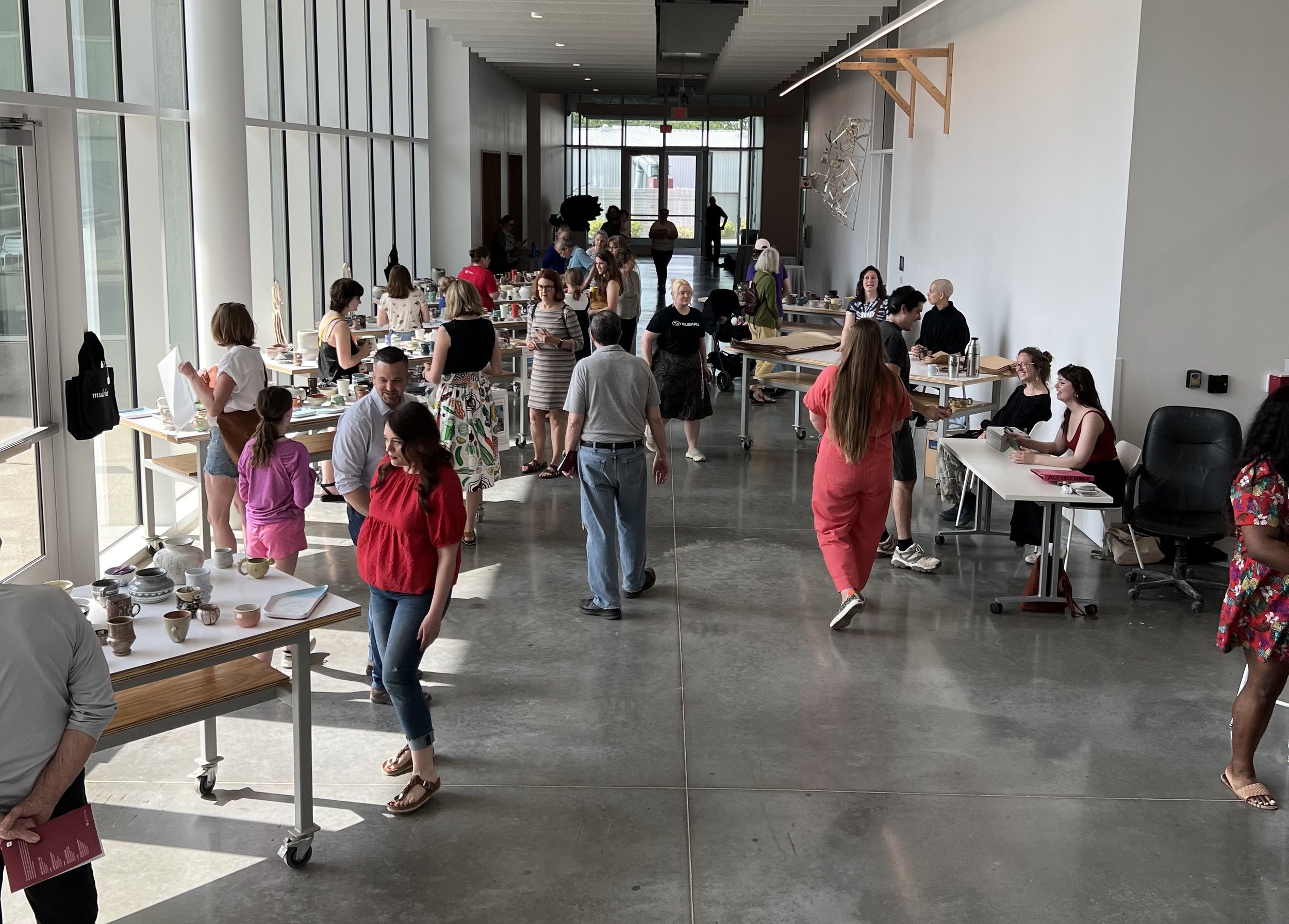
STUDENTS + COMMUNITY
The Ceramics area at the University of Arkansas takes pride in fostering a strong community of artists, working within the studio and as contributors and participants in the burgeoning arts community of our region. We believe students get the best educational experience when they are working actively alongside their peers, whether it is on their own projects, participating in a clay club event, attending a visiting artist lecture, or simply loading a kiln together. To this end, we work hard to make our community one in which inclusiveness and personal diligence coalesce in an experience tailored to bring the best out of each student.
UARK Ceramics hosts a variety of events each semester that students are welcomed and encouraged to attend. In most semesters, there are multiple visiting artists (providing lectures, seminars, and critiques), ACE fundraising events, sponsored events outside the school, and an end-of-semester exhibition. We frequently host resident artists and have an ongoing graduate student exchange with Tainan National University of the Arts.
Our studio provides a year-round hub of activity, and has been expressly designed to place students of all levels in frequent contact in an effort to maximize an open exchange of ideas. At any given time, we typically have six faculty, six M.F.A. students, four post-baccalaureate residents, and a dozen or more B.F.A. Ceramics students working in close proximity (in addition to the 70-100 students enrolled in lower-level courses). The strength and dynamism of our program is unparalleled in this region.
The School of Art provides a robust schedule of exhibitions, visiting artist lectures, and other art-related events. There are far more events happening in the School of Art than any one person could reasonably attend. Within the Studio Art and Design Center, there are five generously-sized student install and critique spaces, in which B.F.A. shows, MFA thesis shows, and many other exhibitions are frequently occurring.
Beyond campus, Northwest Arkansas is home to many different arts organizations and events; arts programming in the region is plentiful. Fayetteville is home to the Walton Arts Center, which brings Broadway quality theater, musical performances, and an art gallery to the city, as well as Theatre Squared, a impeccable stage for small-scale productions. And, if you venture just a few miles up the road, there are even more things to do. Bentonville (home to Crystal Bridges, The Momentary, and 21C) is a community deeply committed to integrating world-class art into the fabric of its identity, and drives much of the region’s
One of the fastest-growing regions in the country, Northwest Arkansas is home to over 450,000 residents and offers many unique cultural experiences. There are great restaurants and nightlife, an excellent farmer’s market, and a historic downtown area. Fayetteville is regularly listed as one of the top places in the US to live, by Forbes, BusinessWeek, and others. It is a bicycle friendly town (Fayetteville was the first city in the United States to be named a "Bike City" by the Union Cycliste Internationale), with trails and greenways to help get you around, and there is an abundance of outdoor activities in the surrounding Ozark Mountains.
Quick InfoDegrees Offered Course Information Clay Break Location |
STAY UPDATEDTo see current and past student and faculty work, as well as stay updated with the latest info and events, follow @uarkart, @uarkceramics, and @ace_uark on Instagram.Instagram |
